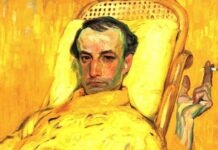by Elizabeth Freeman, University of California Davis
~
Sometime during the days when all the Facebook photos of José with his friends flooded in, José looking at once noble and goofy, fiercely handsome and anime-cute, I had a vision of a T-shirt with a black-and-white, high-contrast picture of José’s face. It would echo the Cuban photographer Alberto Korda’s famous photo of Che Guevara as made over by Andy Warhol–you know the one. The T-shirt would of course disidentify with Che, capturing and redeploying a certain Latino butchness, a certain solidarity with the freaky people, faggot-style. It would come in turquoise, fuschia, tangerine, sweat yellow, and ACT UP white. José’s many friends, so many that we have not all met, would glimpse one another disappearing down subway staircases or turning corners at conferences or lurking at dingy bars. And we’d know we always had more comrades to meet.
What did José teach me about X? Look, we were girls together, kids from fancy liberal arts colleges who arrived at graduate school to do what we did not yet know to call queer theory in about 1990. I can’t say I’ve ever pivoted my own work directly around a particular term or scholarly move of José’s, though rereading him always reminds me that I owe him even more citations even than I thought I did. For example, he understood camp as a memorial practice long before I got there: “like a melancholic subject holding on to a lost object, a disidentifying subject works to hold onto this object and invest it with new life” (Disidentifications, 12). I’m working on sacramentality now, on the sacramental as a way of imagining a history of sexuality that doesn’t march relentlessly toward the secular, and it turns out Cruising Utopia already knows a lot of what I’m trying to say when I wrote this sentence: “queer culture parts ways with New Historicism by treating [a] fragment as a doorway not just into ‘the past,’ but into a series of complex temporal relations: acknowledgements of contemporary paradoxes and struggles, invocations of a future to come, surrogate relations to the dead, nonlinear models of descent (and dissent).” I think I’ll read José from here on the way so many of us now read Eve Sedgwick, seeing the things I am struggling to come to already there in work dating back to the early 1990s. I can live with that temporal twist, though: he lives in a future I haven’t reached yet.
But the Che/José T-shirt vision recalls me to a moment that José cites in Disidentifications. This vision and this moment don’t fit the academic-legacy, high theory model I’ve been struggling to figure out how to inhabit for this in memoriam (I struggle in part because if he’s dead, we are no longer thinking the same cultural moment together, not in any literal way, and that’s too painful). Anyway, José cites Augie Roble’s 1993 documentary Cholo Joto, where Valentín describes seeing a mural of Che accompanied by a quote: “A true rebel is guided by deep feelings of love” (quoted in Disidentifications, 14). José reads Valentín’s response to this quote—“I’m not going to fight out of anger but because I love myself and I love myself and I love my community”—as a disidentifying rearticulation of masculinist Chicano nationalism in queer terms, a way of reanimating of the lost homoerotic valences of early nationalist thought (15). And that is not wrong. But in 1993, this quote had another future too.
“A true rebel is guided by deep feelings of love.” Yeah, that’s right, as Valentín puts it – that could go on the T-shirt, too. Because what José taught me was less a theory or an argument than a method of being in the world as a researcher, a writer, a teacher, and a denizen of multiple worlds (in his case, underworlds). Here is a thing everyone knows about José: he loved a scene he wasn’t the center of. He liked to set them spinning, step back, and make exquisite fun of them. His scenes were the opposite of the traditional dramatological kind: you never knew when they’d start (except never on time) or finish (though always after hours). They often changed locations. The personnel shifted regularly. They had no goals and they had multiple, multi-tentacled conflicts. José loved drama; pretty much everything lesbians did, for example, was already performance art to him. Yet—and it took insecure me a couple of years to figure this out—all of his social mongering and fomenting, all his screwball choreography, was a practice of love. In other words, it really was all about you, not about him. He made it for you. A friend of mine left his memorial in New York last weekend saying, “What I learned from José was to have more parties.”
That is not not theory. José built the worlds he thought about. In his work, and in any number of concrete spaces from the classroom to the lecture hall to the gallery to the club, he created glorious mash-ups of artists and academics, oddballs and wannabes, the fabulous and the pasty-faced. Though you might wonder sometimes if you were cool enough to keep up, nobody was ever the butt of anything for more than a minute, though he did quip about his life as a matchmaker, mentor, network-tangler, and slut, that everything happened in “This Bridge Called My Crack.”1 His rebellion—sneaky boy!—was not to leave anyone out, not to limit his conversations with those as well-educated as he, not to read people’s work contemptuously or decide who was smart enough and who wasn’t (at least, not in public—what he said off the record sometimes traveled, but it was always too funny to hurt much). His party could always be bigger.
So a lot of us who knew José Muñoz, thought with him, cruised with him, laughed with him, made fun of ourselves with him, I think a lot of us have taken up his practice of rebelling against the academy’s, the art world’s, the “community’s,” the Queer Mafia’s most banal forms of cruelty, though he left and we will still leave room, please, for a good joke cracked about anyone. Professionally—to narrow the world a bit, just for a moment—this has meant: figure out what someone is saying even if it sounds like crazytalk. Introduce people to one another. Don’t be afraid of people who are smarter than you. Consider everyone’s success a piece of yours, too. Cite down, gossip up, psychoanalyze lushly and lovingly, invite everyone in. Rebel against the idea that we’re narrowing the gates because these gates—the ones you can see, like tenure-track jobs or book awards or art stardom or the velvet ropes at the coolest club—they are not the ones that count. The ones that count are in front of José’s heaven, and they are wide open. So get out that T-shirt. Put it on, it’s the only thing we have to wear.
_____
Visit the full José Esteban Muñoz gallery here.
_____
Notes
1. Muñoz’s essay “Feeling Brown: Ethnicity and Affect in Ricardo Bracho’s The Sweetest Hangover (and Other STDs)” (in Theatre Journal 52 [2000]: 67-79) includes a subsection entitled “This Bridge Called My Crack.”
Back to essay




